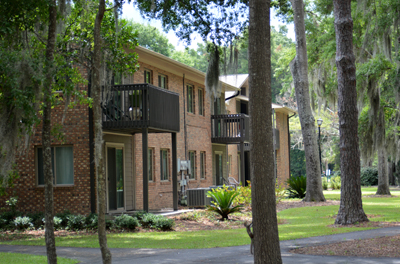- MAKE PAYMENTS
- PUBLIC NOTICES
- CONTACT
- INFORMATION RELEASE FORM
- Landlords, sign-up to list your properties today on SCHousingSearch.com.

Affordable Housing Benefits Everyone
Yes in My Back Yard (YIMBY)
What Does Affordable Housing Look Like?
You simply cannot identify an affordable housing development by the way it looks! The photo here represents an affordable apartment serving low- and moderate-income households in South Carolina. Many of these apartments, condominiums or single-family homes have won design awards. Others have helped reduce crime and revitalize communities.
They all share one thing in common – they have been built, developed or preserved by a private partner with the financial assistance of SC Housing and other public entities.
Affordable housing doesn’t look any different than its “market-rate” counterparts. The difference is what the household pays in rent or mortgage, which is based upon household income.
The Benefit of Homes Within Reach
Without affordable housing choices, the entire community suffers. Increasing the predictability and stability of the housing market helps keep neighborhoods vital and promotes diversity. Everyone benefits when critical workers such as teachers, healthcare workers, military personnel and public safety professionals can live within the communities they serve.
when they know that their workers will be able to afford to live near their workplace. Offering a diverse inventory of housing options close to job centers strengthens South Carolina’s competitive position in attracting and retaining businesses.
when fewer low-wage workers must drive long distances to work, increasing traffic congestion and reducing the time they have to spend with family or on community activities.
when children are able to stay at the same school district for the long term. There are fewer classroom disruptions, schools can count on stable average daily attendance receipts to plan an effective budget, and children are able to focus on learning without worrying about moving during the school year.
since most affordable home developments are more compact, using land more efficiently. Built in infill locations, closer to jobs and services, affordable housing developments reduce vehicle miles traveled, greenhouse gas emissions and pressure on open space.
when parents, adult children and grandchildren have options for living near each other, maintain strong relationships and provide mutual support. When older adults can afford to remain near family, friends or in housing near services on which they depend, there are more opportunities for socializing and access to medical care, which contributes to better physical and mental well-being. When a family moves into an affordable home, the savings realized can be spent on other basic necessities and goods or services, which pumps more revenue into the local economy.
Children living in a stable home experience fewer problems than homeless or transient children in terms of school, nutrition, stress, illness and mental health. They have safer places to play, less exposure to violence, and an ongoing place to share family time.
The foundation of a healthy community—education, jobs, economic prosperity—begins at home. Providing housing to serve a wide array of income levels creates the strong residential base needed to support and shape economic growth.
Six Myths of Affordable Housing
1: Myth: Affordable Housing lowers property values.
Reality: Well designed, properly managed affordable housing developments do not have a negative effect on neighboring property values. Vacant and blighted properties that have been developed into housing have spurred investment in neighboring properties, actually raising values in the adjacent areas.
2: Myth: Affordable Housing increases crime.
Reality: There is no correlation between safe, decent and affordable housing and crime. What does cause crime is community disinvestment, overcrowding, and the lack of jobs and community services. Failure to build affordable housing leads to blight, conditions of overcrowding, absentee ownership, and deteriorating properties with no alternatives for low income families.
3: Myth: Affordable Housing produces more traffic.
Reality: Building affordable housing near jobs supports the use of public transportation, shortens commutes and eases congestion.
4: Myth: People in affordable housing won’t fit into my neighborhood.
Reality: Affordable simply means that housing shouldn’t cost more than 30 percent of the household income—the same standard used by banks in approving home mortgages. Most residents of affordable housing developments have full-time jobs.
5: Myth: Affordable Housing overburdens public schools and infrastructure.
Reality: Infrastructure costs per unit decline significantly as density increases, and, with greater school stability due to the availability of affordable housing, public schools benefit from improved academic performance and test scores.
6: Myth: Affordable Housing is ugly.
Reality: The latest generation of affordable and mixed-use housing is based on good planning, minimal impact and re-creating the neighborhood design. Affordable housing can fit the style and size of any community. It is privately owned, designed and developed.
Reprinted with permission of the City of San Diego Redevelopment Agency.
